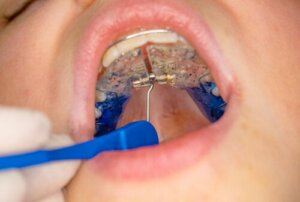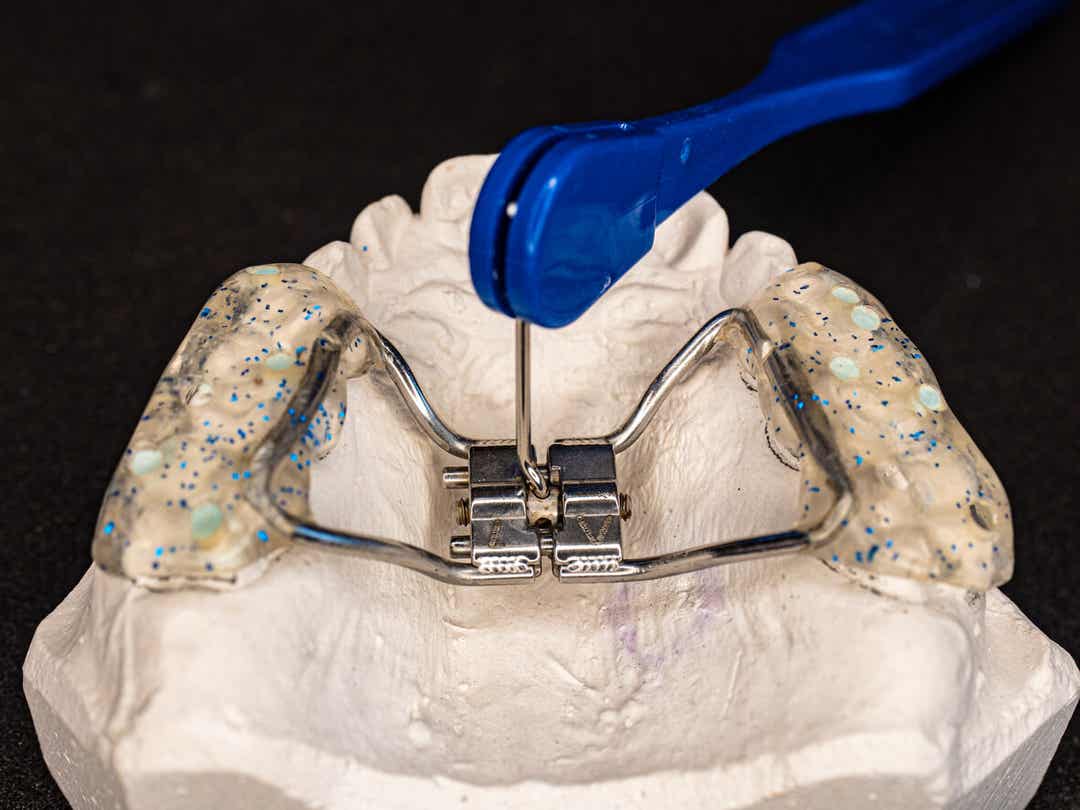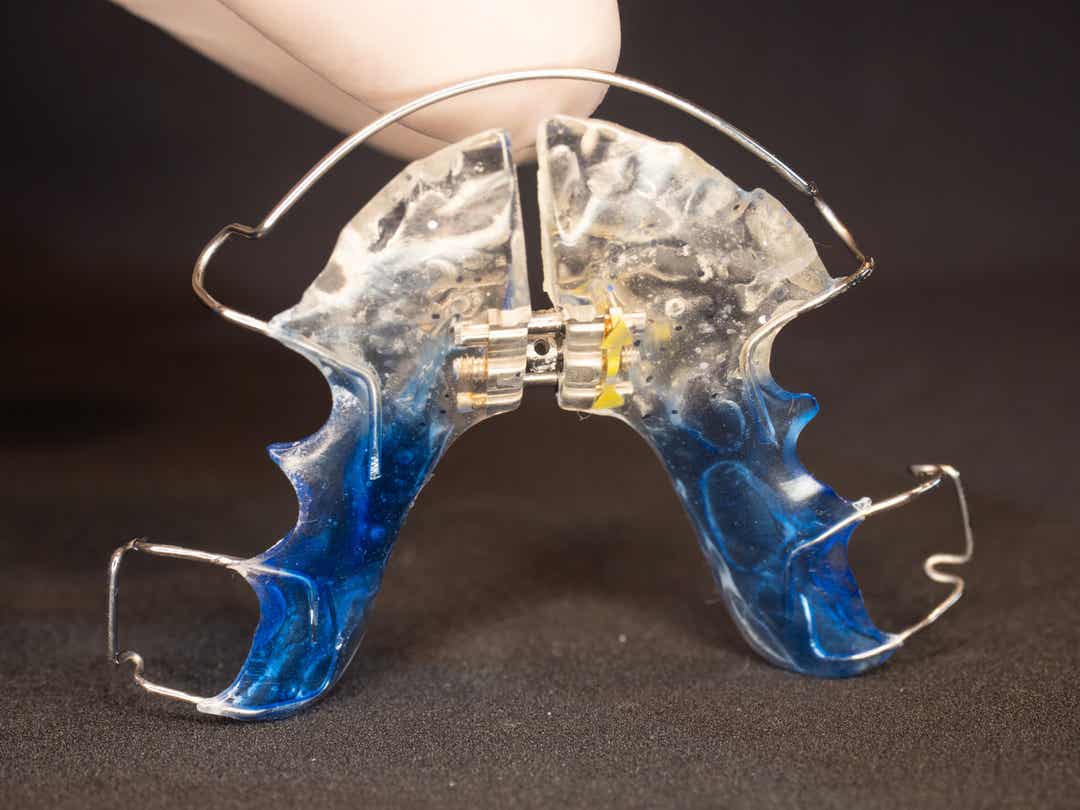Ogival or High-Arched Palate in Children

An ogival or high-arched palate in children is a problem that can appear during childhood. Detecting and correcting it early prevents future complications in the adult mouth.
Treating this anomaly when the maxillary bones are developing is easier, faster, and more effective. Hence the importance of addressing it during childhood.
Here, we’ll tell you what a high-arched palate in children is, its causes, and you can detect it. We’ll also tell you how to can solve this problem.
What’s a high-arched palate in children?
The palate is the upper portion of the oral cavity and has a domed shape. It’s divided into two portions:
- The hard palate: is the anterior part of this structure. It’s formed by bony tissue (the maxillary and palatine bones) covered by mucosa.
- The soft palate: this refers to the posterior part and consists of muscular tissue.

During bone development, if the bony structures don’t form correctly and the width of the palate becomes too narrow, we have an ogival palate. Therefore, the roof of the mouth will be very deep with a very pronounced curvature.
In turn, this deformation in the oral anatomy can cause occlusion problems such as crossbites, crowded, or poorly positioned teeth. This affects the smile of the little ones and the functions of the mouth, so it should be treated as soon as possible.
Causes of a high-arched palate
The origin of the ogival palate in children may be due to genetic causes or to external factors that affect bone development. Among the latter, the following dysfunctional habits are the most frequent causes:
- Mouth breathing: this is common in little ones with respiratory problems, such as chronic nasal obstructions, adenoid vegetations, or a deviated septum. This causes them to use the mouth to breathe instead of the nose.
- Thumb-sucking: the repetitive and impulsive habit of thumb-sucking affects normal bone growth, as the pressure of the thumb against the palate and teeth deforms the area.
- Prolonged pacifier and bottle use: the persistence of this type of sucking after two years of age, as in the previous example, affects the normal growth of the maxilla.
How is a high-arched palate diagnosed in children?
Parents can detect breathing problems in their children and be aware of the dysfunctional habits we just mentioned. But a dentist’s responsible for the detection and diagnosis of this anomaly.
For this reason, it’s essential to take children to frequent dental checkups from an early age. In addition, consultations with an orthodontist from the age of six years help to detect any problems in the child’s bite in time.
Treatment
Treating an ogival palate in children is ideal because, as we’ve already mentioned, during childhood, the bone is still growing and the therapies are simpler, faster, and more effective.
It’s best to intervene as soon as a dentist detects the problem. Preferably, treatments begin from the age of six or seven, although there’s usually time to act in a timely manner until the age of twelve.
The treatment of choice is interceptive orthodontics. These take advantage of the bone malleability of childhood to guide bone growth.
The appliance orthodontists use is a palatal disjunctor or expander. It’s anchored in the upper molars and, in the center, it has an attachment that allows for sideways pressure. In this way, the upper jaw is gradually widened. The time of use depends on each clinical case and the amount of expansion needed. But, in general, the child will use it for seven to twelve months.
Eliminating the habits or factors that cause the high-arched palate is also vital for the treatment to be comprehensive and to avoid recurrences. Teamwork with otorhinolaryngologists and speech therapists is often necessary.

When the expected expansion has been achieved, the child’s palate continues to grow normally. In some cases, further orthodontic treatment must follow the original therapy. As already mentioned, a cleft palate in children often causes other occlusion problems, such as crowding, dental malposition, and crossbites, which also require correction.
Consultations with the orthodontist are essential
We’ve already told you how important it is to take your child to the dentist from an early age. Early detection of an ogival palate in children allows for immediate intervention and avoids complications and more difficult treatments.
If a high-arched palate doesn’t receive treatment in childhood, interventions are much more difficult, time-consuming, uncomfortable, and costly once the bone’s already finished forming. Interceptive orthodontics is only an option during childhood. So, in adults, the therapies combine maxillary surgery and orthodontics.
As you’ll see, the solutions in adults are much more aggressive and painful. So, visiting the orthodontist regularly, from the age of six, is most advisable.
A timely diagnosis and treatment won’t only prevent future problems, but will also help your child to have a healthy smile and a functional mouth during childhood.
An ogival or high-arched palate in children is a problem that can appear during childhood. Detecting and correcting it early prevents future complications in the adult mouth.
Treating this anomaly when the maxillary bones are developing is easier, faster, and more effective. Hence the importance of addressing it during childhood.
Here, we’ll tell you what a high-arched palate in children is, its causes, and you can detect it. We’ll also tell you how to can solve this problem.
What’s a high-arched palate in children?
The palate is the upper portion of the oral cavity and has a domed shape. It’s divided into two portions:
- The hard palate: is the anterior part of this structure. It’s formed by bony tissue (the maxillary and palatine bones) covered by mucosa.
- The soft palate: this refers to the posterior part and consists of muscular tissue.

During bone development, if the bony structures don’t form correctly and the width of the palate becomes too narrow, we have an ogival palate. Therefore, the roof of the mouth will be very deep with a very pronounced curvature.
In turn, this deformation in the oral anatomy can cause occlusion problems such as crossbites, crowded, or poorly positioned teeth. This affects the smile of the little ones and the functions of the mouth, so it should be treated as soon as possible.
Causes of a high-arched palate
The origin of the ogival palate in children may be due to genetic causes or to external factors that affect bone development. Among the latter, the following dysfunctional habits are the most frequent causes:
- Mouth breathing: this is common in little ones with respiratory problems, such as chronic nasal obstructions, adenoid vegetations, or a deviated septum. This causes them to use the mouth to breathe instead of the nose.
- Thumb-sucking: the repetitive and impulsive habit of thumb-sucking affects normal bone growth, as the pressure of the thumb against the palate and teeth deforms the area.
- Prolonged pacifier and bottle use: the persistence of this type of sucking after two years of age, as in the previous example, affects the normal growth of the maxilla.
How is a high-arched palate diagnosed in children?
Parents can detect breathing problems in their children and be aware of the dysfunctional habits we just mentioned. But a dentist’s responsible for the detection and diagnosis of this anomaly.
For this reason, it’s essential to take children to frequent dental checkups from an early age. In addition, consultations with an orthodontist from the age of six years help to detect any problems in the child’s bite in time.
Treatment
Treating an ogival palate in children is ideal because, as we’ve already mentioned, during childhood, the bone is still growing and the therapies are simpler, faster, and more effective.
It’s best to intervene as soon as a dentist detects the problem. Preferably, treatments begin from the age of six or seven, although there’s usually time to act in a timely manner until the age of twelve.
The treatment of choice is interceptive orthodontics. These take advantage of the bone malleability of childhood to guide bone growth.
The appliance orthodontists use is a palatal disjunctor or expander. It’s anchored in the upper molars and, in the center, it has an attachment that allows for sideways pressure. In this way, the upper jaw is gradually widened. The time of use depends on each clinical case and the amount of expansion needed. But, in general, the child will use it for seven to twelve months.
Eliminating the habits or factors that cause the high-arched palate is also vital for the treatment to be comprehensive and to avoid recurrences. Teamwork with otorhinolaryngologists and speech therapists is often necessary.

When the expected expansion has been achieved, the child’s palate continues to grow normally. In some cases, further orthodontic treatment must follow the original therapy. As already mentioned, a cleft palate in children often causes other occlusion problems, such as crowding, dental malposition, and crossbites, which also require correction.
Consultations with the orthodontist are essential
We’ve already told you how important it is to take your child to the dentist from an early age. Early detection of an ogival palate in children allows for immediate intervention and avoids complications and more difficult treatments.
If a high-arched palate doesn’t receive treatment in childhood, interventions are much more difficult, time-consuming, uncomfortable, and costly once the bone’s already finished forming. Interceptive orthodontics is only an option during childhood. So, in adults, the therapies combine maxillary surgery and orthodontics.
As you’ll see, the solutions in adults are much more aggressive and painful. So, visiting the orthodontist regularly, from the age of six, is most advisable.
A timely diagnosis and treatment won’t only prevent future problems, but will also help your child to have a healthy smile and a functional mouth during childhood.
All cited sources were thoroughly reviewed by our team to ensure their quality, reliability, currency, and validity. The bibliography of this article was considered reliable and of academic or scientific accuracy.
- STAGE, HABIT IN A. CHILDHOOD. “EFECTOS CAUSADOS POR EL HÁBITO DE SUCCIÓN DIGITAL EN ETAPA INFANTIL.” Revista Científica “Especialidades Odontológicas UG 2019: 1. http://www.revista.eoug.ug.edu.ec/wp-content/uploads/2019/09/6-1.pdf
- Ramos-Ríos, Juana Angélica, et al. “Repercusiones en la salud bucodental asociadas con el asma en niños de 6 a 12 años de edad.” Revista Alergia México 64.3 (2017): 270-276. http://www.scielo.org.mx/scielo.php?script=sci_arttext&pid=S2448-91902017000300270
- Casarán, Ana María, et al. “Evaluación clínica de la respiración bucal.” IV Jornadas de Actualización en Prácticas Odontológicas Integradas PPS-SEPOI (La Plata, 7 de julio de 2020). 2020. http://sedici.unlp.edu.ar/handle/10915/100666
- Botero Mariaca, Paola María, et al. “Manual de ortodoncia interceptiva: teoría y práctica.” (2020). https://repository.ucc.edu.co/handle/20.500.12494/20633
- Carrasco-Sierra, Miguel, Alba M. Mendoza-Castro, and Freya M. Andrade-Vera. “Implementación de la ortodoncia interceptiva.” Dominio de las Ciencias 4.1 (2018): 332-340. https://www.dominiodelasciencias.com/ojs/index.php/es/article/view/745
- CARBALLO ZURITA, P. A. T. R. I. C. I. A. “Plan de Asignatura ORTODONCIA INTERCEPTIVA Plan de Unidad de Aprendizaje APARATOS REMOVIBLES Y FUNCIONALES EN ORTODONCIA INTERCEPTIVA.” (2019). http://ddigital.umss.edu.bo:8080/jspui/handle/123456789/16898
- Piñeda Zayas, Alejandro. “Ortodoncia interceptiva en paciente infantil con hábito de succión no nutritivo.” (2019). https://eprints.ucm.es/id/eprint/56270/
This text is provided for informational purposes only and does not replace consultation with a professional. If in doubt, consult your specialist.








